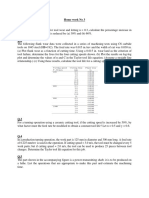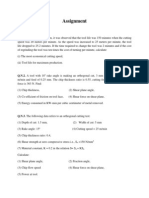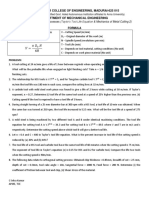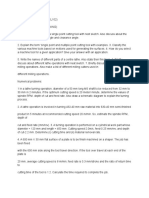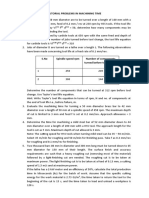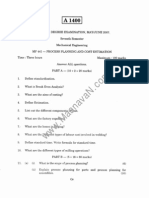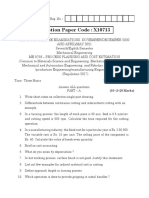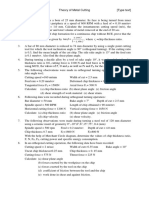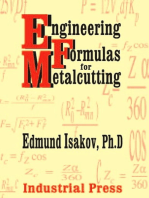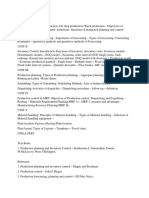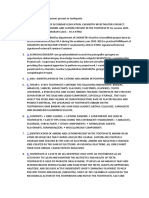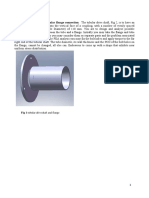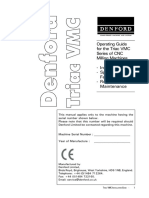0 ratings0% found this document useful (0 votes)
38 viewsCutting Force Thrust Force
Cutting Force Thrust Force
Uploaded by
pmagrawalThis document contains multiple questions related to machining processes and calculations. It asks to:
1) Explain the differences between orthogonal and oblique machining, and describe the composition of 18-4-1 HSS tool material.
2) Discuss the consequences of allowing temperatures to rise too high during cutting.
3) Calculate cutting speeds, tool changes, tool life, cycle times, and cutting forces for different turning operations based on given process parameters and tool life equations.
4) Analyze location systems for workpieces and explain redundant location.
5) Determine maximum feed and cutting force based on motor power, efficiency, specific energy, depth of cut, and cutting speed.
Copyright:
© All Rights Reserved
Available Formats
Download as PDF, TXT or read online from Scribd
Cutting Force Thrust Force
Cutting Force Thrust Force
Uploaded by
pmagrawal0 ratings0% found this document useful (0 votes)
38 views1 pageThis document contains multiple questions related to machining processes and calculations. It asks to:
1) Explain the differences between orthogonal and oblique machining, and describe the composition of 18-4-1 HSS tool material.
2) Discuss the consequences of allowing temperatures to rise too high during cutting.
3) Calculate cutting speeds, tool changes, tool life, cycle times, and cutting forces for different turning operations based on given process parameters and tool life equations.
4) Analyze location systems for workpieces and explain redundant location.
5) Determine maximum feed and cutting force based on motor power, efficiency, specific energy, depth of cut, and cutting speed.
Original Description:
Production Technology Sample Question Paper
Original Title
PT_SQP
Copyright
© © All Rights Reserved
Available Formats
PDF, TXT or read online from Scribd
Share this document
Did you find this document useful?
Is this content inappropriate?
This document contains multiple questions related to machining processes and calculations. It asks to:
1) Explain the differences between orthogonal and oblique machining, and describe the composition of 18-4-1 HSS tool material.
2) Discuss the consequences of allowing temperatures to rise too high during cutting.
3) Calculate cutting speeds, tool changes, tool life, cycle times, and cutting forces for different turning operations based on given process parameters and tool life equations.
4) Analyze location systems for workpieces and explain redundant location.
5) Determine maximum feed and cutting force based on motor power, efficiency, specific energy, depth of cut, and cutting speed.
Copyright:
© All Rights Reserved
Available Formats
Download as PDF, TXT or read online from Scribd
Download as pdf or txt
0 ratings0% found this document useful (0 votes)
38 views1 pageCutting Force Thrust Force
Cutting Force Thrust Force
Uploaded by
pmagrawalThis document contains multiple questions related to machining processes and calculations. It asks to:
1) Explain the differences between orthogonal and oblique machining, and describe the composition of 18-4-1 HSS tool material.
2) Discuss the consequences of allowing temperatures to rise too high during cutting.
3) Calculate cutting speeds, tool changes, tool life, cycle times, and cutting forces for different turning operations based on given process parameters and tool life equations.
4) Analyze location systems for workpieces and explain redundant location.
5) Determine maximum feed and cutting force based on motor power, efficiency, specific energy, depth of cut, and cutting speed.
Copyright:
© All Rights Reserved
Available Formats
Download as PDF, TXT or read online from Scribd
Download as pdf or txt
You are on page 1of 1
Q.
1
(a)
(a)
(b)
(c)
Q.2
(a)
(a)
(b)
(c)
Answer the following questions:
(i) Differentiate between orthogonal and oblique machining.
(ii) What is an 18-4-1 HSS tool material composed of?
(iii) Explain the consequences of allowing temperatures to rise to high levels in
cutting.
---- OR ---Answer the following questions
(i) Explain with neat sketches: (i) Flank wear (ii) Crater wear
(ii) Why the percentage of the total cutting energy carried away by the chip increases
with increasing cutting speed?
(iii) Explain whether it is desirable to have a high or low (i) n value and (ii) C value
in the Taylors tool-life equation.
In a production turning operation, the steel component has a 110 mm diameter and is
450 mm long. A feed of 0.3 mm/rev is used in the operation. If cutting speed = 120
m/min, the tool must be changed every four pieces; but if cutting speed = 80 m/min,
the tool can be used to produce 15 pieces between tool changes. A new batch for 20
pieces has been received but the dimensions of the component have been changed. The
new diameter is 90 mm, and the new length is 380 mm. The work material and tooling
remain the same, and the feed and depth are also unchanged, so the Taylor tool life
equation determined for the previous parts is valid for the new parts. Determine the
cutting speed that will allow one cutting tool to be used for the entire batch
A manufacturing engineer needs an estimate of the cutting force to estimate the loss of
accuracy of a machining process due to deflection. The material has shear strength of
200 MPa. The machining was carried out using a tool with 10 rake angle with a
cutting speed of 120 m/min. The feed was 0.3 mm/rev and the depth of cut was 5.0
mm. The chip from the process measured 0.75 mm thick. Estimate the cutting force
assuming that Cutting force 2 Thrust force . Also Calculate the specific power.
Answer the following questions.
(i) Analyze the location system to be provided in case of: Long cylinder and Short
cylinder.
Evaluate the Degrees of freedom arrested in each case.
(ii) Explain with the help of sketch the location system when two holes in a workpiece
are to be used for location.
---- OR ---Answer the following questions.
(i) Analyze the location system provided by Cylindrical locator and Conical locator.
(ii) Explain with the help of sketch: Redundant location
A high-speed steel tool is used to turn a steel workpiece that is 300 mm long and 80
mm in diameter. The parameters in the Taylor equation are: n = 0.13 and C = 75 for a
feed = 0.4 mm/rev. The operator and machine tool rate = Rs. 300 per hour, and the
tooling cost per cutting edge = Rs. 40. It takes 2.0 min to load and unload the
workpiece and 3.50 min to change tools. Determine (a) cutting speed for maximum
production rate, (b) cutting speed for minimum cost. In each case, also determine the
tool life in min and cycle time.
In a turning operation on plain carbon steel, the cutting speed is set at 200 m/min and
depth of cut = 6.0 mm. The lathe motor is rated at 20 kW, and its mechanical
efficiency = 90%. If the specific energy for the cutting operation = 1.8 J/mm3,
determine the maximum feed that can be set for this operation. What is the maximum
cutting force in this case?
1 of 2
You might also like
- Complete Study PlanDocument4 pagesComplete Study PlanSyeda Eshaal Javaid100% (1)
- Product and Service Design Operations ManagementDocument13 pagesProduct and Service Design Operations ManagementRafael AbanesNo ratings yet
- Tool Life NumericalsDocument2 pagesTool Life Numericalspmagrawal75% (4)
- Weld Like a Pro: Beginning to Advanced TechniquesFrom EverandWeld Like a Pro: Beginning to Advanced TechniquesRating: 4.5 out of 5 stars4.5/5 (6)
- Clamp LocksDocument22 pagesClamp LocksBhagirath NagarajuNo ratings yet
- Home Work No 3Document2 pagesHome Work No 3HarishNo ratings yet
- TUTORIALS 1 (1) - MergedDocument23 pagesTUTORIALS 1 (1) - MergedRUGERO KeslyneNo ratings yet
- Cos Tan Here Is The Chip T 1 Si Hickness Ratio. N: R R R WDocument1 pageCos Tan Here Is The Chip T 1 Si Hickness Ratio. N: R R R WpmagrawalNo ratings yet
- Question Bank (PPII)Document7 pagesQuestion Bank (PPII)Udaiyar BarathadhithyaNo ratings yet
- Tutorial#10-Module 3-MECH4012-20201Document5 pagesTutorial#10-Module 3-MECH4012-20201ahmedNo ratings yet
- EMMU 7244-Machine Tool Vibrations and Cutting Dynamics-Exam July 2016Document4 pagesEMMU 7244-Machine Tool Vibrations and Cutting Dynamics-Exam July 2016Charles OndiekiNo ratings yet
- EMMU 7244-Machine Tool Vibrations and Cutting Dynamics-Exam July 2016Document4 pagesEMMU 7244-Machine Tool Vibrations and Cutting Dynamics-Exam July 2016Charles OndiekiNo ratings yet
- 414 TutorialsDocument2 pages414 TutorialsAMOS SIFUNANo ratings yet
- Assign 1 2012Document2 pagesAssign 1 2012chiru1431No ratings yet
- Assignment: Q.N.1. in A Turning Operation, It Was Observed That The Tool Life Was 150 Minutes When The CuttingDocument7 pagesAssignment: Q.N.1. in A Turning Operation, It Was Observed That The Tool Life Was 150 Minutes When The CuttingAnkesh KapilNo ratings yet
- AssignmentDocument2 pagesAssignmentgirma workuNo ratings yet
- Sheets - Sep 2013Document13 pagesSheets - Sep 2013Mohamed OsamaNo ratings yet
- Machining Processes - QuestionDocument2 pagesMachining Processes - QuestionYih Lin ChenNo ratings yet
- Me 014Document2 pagesMe 014Jimmy JindalNo ratings yet
- AssignmentDocument2 pagesAssignmentgirma workuNo ratings yet
- Deber 1Document15 pagesDeber 1jmgavilanes0% (1)
- ME 338 Manufacturing Processes II HW#2Document2 pagesME 338 Manufacturing Processes II HW#2Anonymous 2xjDjAcZNo ratings yet
- EPP201 Pass Paper Revision Questions 1Document9 pagesEPP201 Pass Paper Revision Questions 1Boey Keen HuangNo ratings yet
- Example 2Document5 pagesExample 2girma worku100% (1)
- Theory of Metal Cutting - NumericalsDocument2 pagesTheory of Metal Cutting - Numericalspmagrawal100% (1)
- TA202 AssignmentsDocument1 pageTA202 AssignmentsBrajesh kumarNo ratings yet
- Question Bank For Machining and MetrologyDocument7 pagesQuestion Bank For Machining and MetrologyAbhisheak DineshNo ratings yet
- Manufacturing Engineering Assignment Thapar UniversityDocument5 pagesManufacturing Engineering Assignment Thapar UniversitySaurav Kumar0% (1)
- CAT I - EMMU 7241 - Machine Tool Vibrations and Cutting DynamicsDocument2 pagesCAT I - EMMU 7241 - Machine Tool Vibrations and Cutting DynamicsCharles OndiekiNo ratings yet
- 2023 End Spring Mechanical Engg ME30604 Machine Tools and Machining ES 2023Document5 pages2023 End Spring Mechanical Engg ME30604 Machine Tools and Machining ES 2023riya pandeyNo ratings yet
- UTA026 Manufacturing Processes Work SheetDocument3 pagesUTA026 Manufacturing Processes Work SheetGUNJAN KHULLARNo ratings yet
- HW 2 - Me-572 - 232Document5 pagesHW 2 - Me-572 - 232sseemaNo ratings yet
- Assignment 1 2Document2 pagesAssignment 1 2Jeevan GNo ratings yet
- PI1502 Assignment 2Document1 pagePI1502 Assignment 2Abhishek KumarNo ratings yet
- Manufacturing Processes For Mechanical EngineeringDocument21 pagesManufacturing Processes For Mechanical EngineeringRene EsepejoNo ratings yet
- 02 Taylors Tool Life Problems UpdatedDocument2 pages02 Taylors Tool Life Problems Updated19G133 VASANTH B100% (1)
- Deber 4Document8 pagesDeber 4jmgavilanesNo ratings yet
- PDF MEC3102 Tutorial No 1-ASSIGMENT 1Document4 pagesPDF MEC3102 Tutorial No 1-ASSIGMENT 1Beckham ChaileNo ratings yet
- Rr312404 Design of Machine ElementsDocument9 pagesRr312404 Design of Machine ElementsSrinivasa Rao GNo ratings yet
- Assignment Metal CuttingDocument2 pagesAssignment Metal CuttingthakurkalidassNo ratings yet
- Tutorial-2: Manufacturing Science and Technology-II (ME - 322)Document2 pagesTutorial-2: Manufacturing Science and Technology-II (ME - 322)Deepam ShyamNo ratings yet
- Man ProDocument2 pagesMan ProlividiveNo ratings yet
- Tutorial Problems in Machining TimeDocument2 pagesTutorial Problems in Machining TimeDHANASEKAR K IV A 9023No ratings yet
- Mem603 QBDocument11 pagesMem603 QBAman SinghNo ratings yet
- Tutorial - Metal Removal ProcessDocument2 pagesTutorial - Metal Removal ProcessbananaNo ratings yet
- ME 338 Manufacturing Processes II HW#1Document3 pagesME 338 Manufacturing Processes II HW#1jambu99No ratings yet
- Solution: (a) N = v/πD = 70,000 mm/80 = 279 rev/minDocument11 pagesSolution: (a) N = v/πD = 70,000 mm/80 = 279 rev/minwoihoNo ratings yet
- MC&TDDocument4 pagesMC&TDGopal Krishan0% (1)
- Slip TestDocument3 pagesSlip TestSaravanan MathiNo ratings yet
- Assignment No 1 (ME 461)Document6 pagesAssignment No 1 (ME 461)Jayant Raj SauravNo ratings yet
- انتاج ٢Document9 pagesانتاج ٢khaledfarrag281No ratings yet
- ME 338 Manufacturing Processes II HW#1Document2 pagesME 338 Manufacturing Processes II HW#1Aditya DaveNo ratings yet
- Problem Sheet Metal Machining and Cutting Conditions 2016Document3 pagesProblem Sheet Metal Machining and Cutting Conditions 2016Muhammad imranNo ratings yet
- PPCE May-June 2007Document4 pagesPPCE May-June 2007Mohan MKNo ratings yet
- Time: 3 Hours Answer All Questions Maximum: 100 MarksDocument3 pagesTime: 3 Hours Answer All Questions Maximum: 100 MarksAnonymous ZB6qyhD6No ratings yet
- Virtual Buce 3Document92 pagesVirtual Buce 3Ralph Edward Santiago Moran100% (1)
- Lathe DesignDocument11 pagesLathe DesignShiyas Basheer0% (1)
- Question Paper Code: X10713: (10×2 20 Marks)Document3 pagesQuestion Paper Code: X10713: (10×2 20 Marks)Afsal Mohamed KaniNo ratings yet
- Ece TutorialDocument7 pagesEce TutorialShreeji EnggNo ratings yet
- Assignment No1Document2 pagesAssignment No1netkap17No ratings yet
- Theory of Metal Cutting Numericals PDFDocument2 pagesTheory of Metal Cutting Numericals PDFsanjayNo ratings yet
- Manufacturing ProcessesDocument2 pagesManufacturing ProcessespmagrawalNo ratings yet
- 1 BmeDocument44 pages1 BmepmagrawalNo ratings yet
- Pom IeDocument5 pagesPom IepmagrawalNo ratings yet
- Creo SuppliersDocument1 pageCreo SupplierspmagrawalNo ratings yet
- 3D GeometryDocument3 pages3D Geometrypmagrawal100% (1)
- Unit No. Topics Teaching HoursDocument1 pageUnit No. Topics Teaching HourspmagrawalNo ratings yet
- Vibration AnalysisDocument17 pagesVibration AnalysispmagrawalNo ratings yet
- Commonly Used For:: CartesianDocument9 pagesCommonly Used For:: CartesianpmagrawalNo ratings yet
- 3D GeometryDocument3 pages3D GeometrypmagrawalNo ratings yet
- Fem QuestionsDocument1 pageFem QuestionspmagrawalNo ratings yet
- Robot SensorsDocument1 pageRobot SensorspmagrawalNo ratings yet
- Asrs - FMSDocument2 pagesAsrs - FMSpmagrawalNo ratings yet
- Manual Process PlanningDocument1 pageManual Process PlanningpmagrawalNo ratings yet
- Ma 2264 NM Eee Q.BDocument26 pagesMa 2264 NM Eee Q.BpmagrawalNo ratings yet
- Identification of Cations and Anions Present in ToothpasteDocument4 pagesIdentification of Cations and Anions Present in ToothpastepmagrawalNo ratings yet
- Standard Error of The EstimateDocument3 pagesStandard Error of The EstimatepmagrawalNo ratings yet
- Topics For Active Learning AssignmentDocument1 pageTopics For Active Learning AssignmentpmagrawalNo ratings yet
- Greek Alphabet: Capital Lower-Case Greek Name EnglishDocument1 pageGreek Alphabet: Capital Lower-Case Greek Name EnglishpmagrawalNo ratings yet
- FDiff Cubic 2nd DerivDocument1 pageFDiff Cubic 2nd DerivpmagrawalNo ratings yet
- Tubular Driveshaft and FlangeDocument1 pageTubular Driveshaft and FlangepmagrawalNo ratings yet
- Triac VMCDocument20 pagesTriac VMCpmagrawalNo ratings yet
- Adaptive MeshingDocument1 pageAdaptive MeshingpmagrawalNo ratings yet
- Kovalskii Et Al., 2014, MECHANISMS OF RUTIN PHARMACOLOGICALDocument4 pagesKovalskii Et Al., 2014, MECHANISMS OF RUTIN PHARMACOLOGICALkateNo ratings yet
- Btec Unit 2 Task 1 Assignment Bu Jude 10-ADocument16 pagesBtec Unit 2 Task 1 Assignment Bu Jude 10-AJudes EditsNo ratings yet
- Tom Peter's 7-S ModelDocument2 pagesTom Peter's 7-S ModelsonadoshiNo ratings yet
- The Dread Codex - Goblins PDFDocument97 pagesThe Dread Codex - Goblins PDFSérgio Sanches100% (4)
- DC 6 Digital Gov Data Sheet PDFDocument4 pagesDC 6 Digital Gov Data Sheet PDFCarlos MajanoNo ratings yet
- Unit 4 Price and Output Decisions Under Different Market StructuresDocument108 pagesUnit 4 Price and Output Decisions Under Different Market Structuresjeganrajraj80% (5)
- Differences Between Plant and Animal CellsDocument11 pagesDifferences Between Plant and Animal CellsThet Yadanar ShuneNo ratings yet
- Brandini 2012Document6 pagesBrandini 2012Paulina Vargas DíazNo ratings yet
- B Ethics Pavan Sir NotesDocument290 pagesB Ethics Pavan Sir NotesAnmol SaxenaNo ratings yet
- 9781317290834Document207 pages9781317290834Yoshitomo MoriokaNo ratings yet
- MCA SubjectsDocument33 pagesMCA SubjectsLakshmi PujariNo ratings yet
- GeobagDocument13 pagesGeobagBejo TejoNo ratings yet
- MSP Benchmark Survey ReportDocument19 pagesMSP Benchmark Survey Reportchrisban35No ratings yet
- Smart Homes in India White PaperDocument5 pagesSmart Homes in India White PaperRavi AlagumalaiNo ratings yet
- +3 Degree 6th Semester Programme-2024Document7 pages+3 Degree 6th Semester Programme-2024karunakar81444No ratings yet
- Review of Geosynthetics As A Barrier For Water Table: Proceedings CIGMAT-2019 Conference & ExhibitionDocument3 pagesReview of Geosynthetics As A Barrier For Water Table: Proceedings CIGMAT-2019 Conference & Exhibitionمريم محمدNo ratings yet
- Automation Script Header TemplateDocument2 pagesAutomation Script Header TemplatereachmsmNo ratings yet
- Genesis 4.7 - What Does God Say To CainDocument20 pagesGenesis 4.7 - What Does God Say To Cainbdudgeon85100% (2)
- Guidance and Counseling - REFLECTION PAPERDocument2 pagesGuidance and Counseling - REFLECTION PAPERMariaNo ratings yet
- Cultural Issues in TranslationDocument6 pagesCultural Issues in TranslationMuhammad AdnanNo ratings yet
- WJR 8 581 PDFDocument8 pagesWJR 8 581 PDFEnricoFermihutagalungNo ratings yet
- Arguments Against MonarchyDocument3 pagesArguments Against MonarchyNicoleta Cristina Suciu100% (1)
- Oswestry Disability Index (ODI)Document3 pagesOswestry Disability Index (ODI)Mohamed ZakiNo ratings yet
- Fast Dissolving TabletsDocument17 pagesFast Dissolving TabletsKamesh TripathiNo ratings yet
- BaptismDocument16 pagesBaptismMarko Zero FourNo ratings yet
- Wangyour Antoine Resume 4Document1 pageWangyour Antoine Resume 4api-748554886No ratings yet
- Introduction To Linux I Chapter 23 Exam AnswerDocument4 pagesIntroduction To Linux I Chapter 23 Exam AnswerElena PaulNo ratings yet






